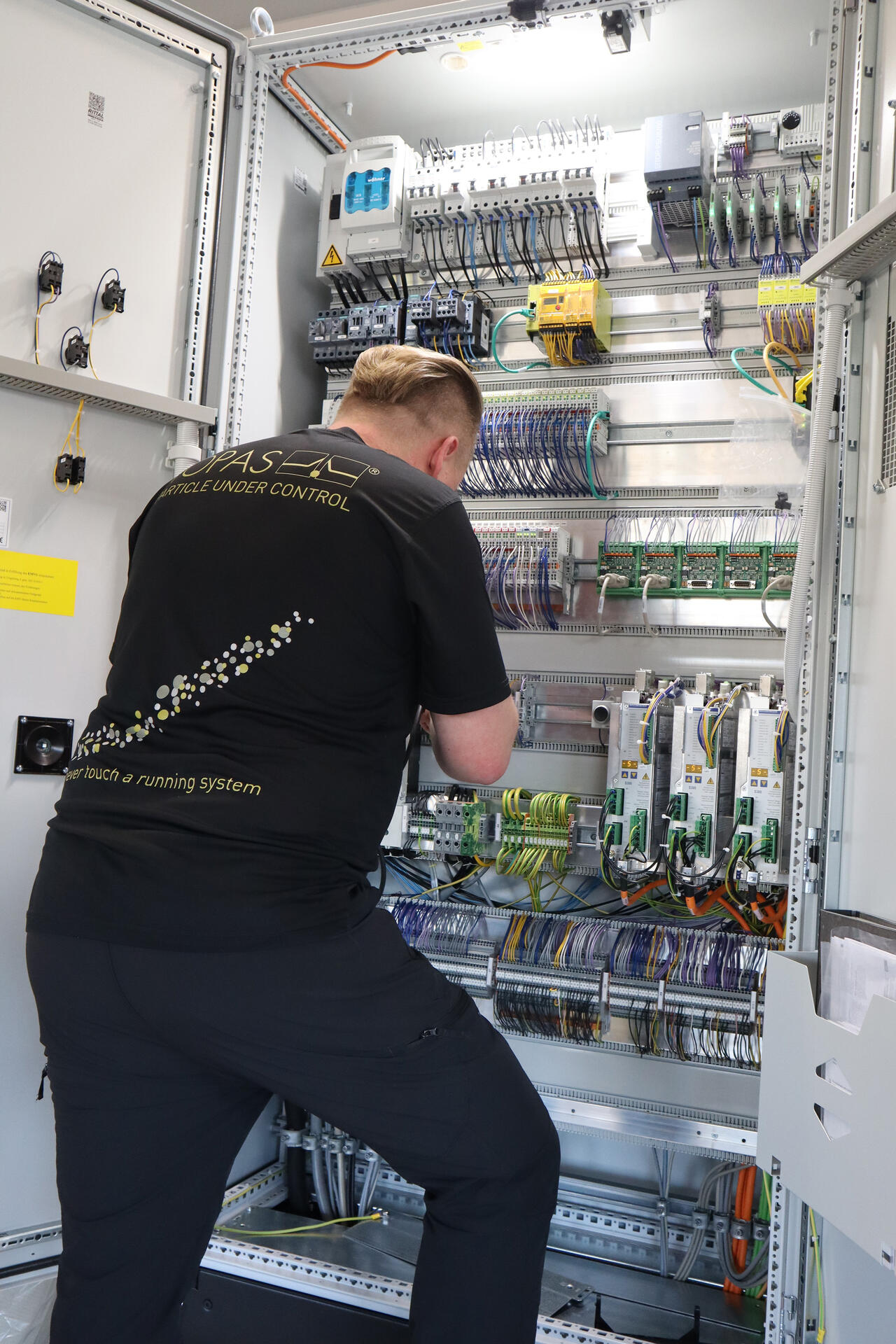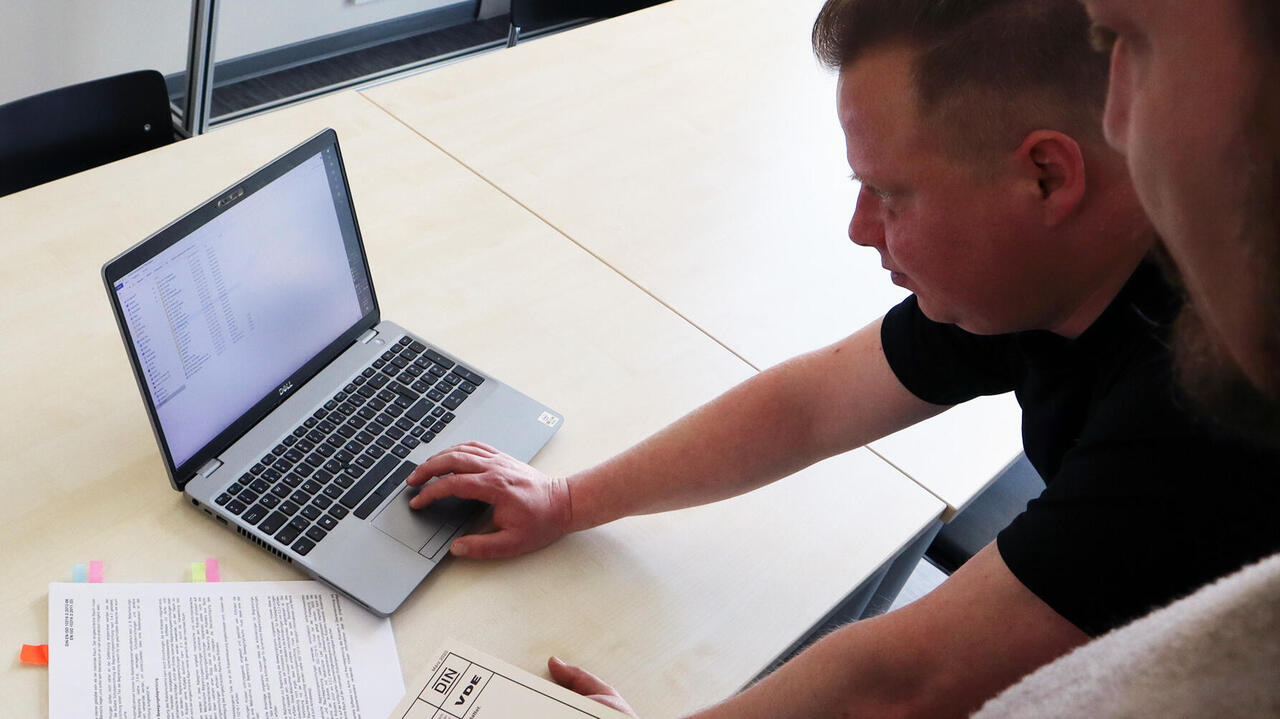Production hall, desk and back again – Stefan Haufe is on the road a lot during his working day. The state-certified technician for mechatronics has been working at Topas since 2010 and has achieved and moved a lot since then.
After his apprenticeship as a mechatronics engineer in Munich, he completed his vocational secondary school in Dresden. During his studies at the Hochschule für Technik und Wirtschaft Dresden (HTW) – University of Applied Sciences, the current assistant to the team manager realized that automation and computer technology were fields to better develop and deepen practically and started his career at the aerosol and particle specialist. As the 28th employee in a comparatively small team, he took on various tasks as a mechatronics technician within his professional field and beyond. He was responsible for electrical assembly, PLC programming ((Programmable Logic Controller) and the worldwide initiation of Topas test systems. He was the contact person for programming and software at the customer’s site in the USA, China, or Sweden, just to name a few countries. With each foreign assignment, he deepened his knowledge. Machine safety became more and more complex and, thanks to the good situation with orders and the ever-increasing number of test systems and devices. This was a labor-intensive topic, which Topas wanted to expand with more personnel capacity. Stefan Haufe wrote new documents on machine safety and designed innovative tools for finding faults, such as acceptance routines or checklists, which had not previously existed in this form. Whereas there were fewer than ten protocols at that time, today’s CE officer handles more than 40 protocols for the acceptance of filter test systems that are in demand worldwide.
Promotion of continuing and advanced training for a successful corporate future
In addition to his work as a PLC and safety expert, his current area of work primarily involves customer support via remote maintenance. Here, he answers fault inquiries in the area of machine control, exchanging ideas with the application engineers as well as the sales department and keeping the entirety of the testing system in mind. In addition to contributing to the technical documentation and operating instructions of a testing system, he works a lot on innovations in the area of CE conformity and on the further development of machine safety at Topas. “Knowledge is safety,” is how the technician explains his drive and interest in this subject. He greatly appreciates the fact that Topas supported his further training as a state-certified technician for mechatronics, which took place parallel to his work. The company also supported his further certifications as a CE officer TÜV and as a CMSE® (Certified Machinery Safety Expert), thus bringing expertise in the areas of product conformity and safety in-house.
What distinguishes an electronics technician at Topas?
To be able to work at Topas in the field of electrical assembly, you need curiosity, enthusiasm for technology and, due to the company’s foundation in special machine construction, the will to always think outside the box, explains the technician. Programmers should also have a basic understanding of testing processes and Topas’ own systems or be willing to familiarize themselves with them. A high level of complexity determines the day-to-day work, because processing measured values already begins in the control technology. Interaction with other systems such as particle counters, positioning systems or, more recently, robotics is also part of the job. Technical documents such as data sheets and operating instructions, some of which have to be read in English, are part of the daily routine. Electronics technicians at Topas assemble, wire, and test. When installing, maintaining, and repairing the systems, they are sometimes in direct contact with customers. Since there are no large production machines running at Topas, the work of the electronics technicians is mostly trouble-free and quiet. Short distances to colleagues, a convenient location, and accessibility are further positive conditions that the technician appreciates about his employer.
Interface employees are in demand
Today, Stefan works at the interface between electrical assembly and PLC software. The challenge here is to visualize and process test signals for electricians, but also for engineers and not least for the customer. As CE officer, he is also closely networked with the engineers and advises them on changing standards and regulations. Further tasks in this work area are project planning and the validation of technical protective measures as well as their corresponding documentation in the field of machine safety. These measures concern the entire product life cycle, from construction through the working life to the (eventual) disposal of a test system. For this reason, the technician also works together with a number of other departments such as research and development, purchasing or software engineering.
Delivery delays also play a major role in his field of work. Controls and safety technology are vendor parts that are currently in short supply. Here, the technician has been looking for alternative solutions and suppliers for some time. It is good that Topas can rely on flexible solutions for these additional workloads through special machine construction and thus still has time for development and planning of the machines.
Variety in daily activities with very special facilities
His great interest in machine construction and the pleasant size of the medium-sized company were good reasons for the safety expert to choose Topas as his employer; his curiosity about the niche industry and the topic of aerosols was awakened in him during his work. To this day, he appreciates the daily variety and that his work challenges and encourages him. “The fact that we build such special machines makes me proud,” says Stefan Haufe. The most significant test stand for him remains the FST 144 test system, about which he also wrote his engineering thesis. In this test system, a traversing system automatically scans the air flow profile of components used in the intake tract of combustion engines – and, in general, anything that moves is particularly exiting for the technician. He finds the best balance to all this technology in nature, whether it’s hiking, trekking in Saxon Switzerland, or paddling on the river Elbe. The only thing he likes even more is taking pictures. And, every now and then, a Topas-Model makes it in front of his lens.




